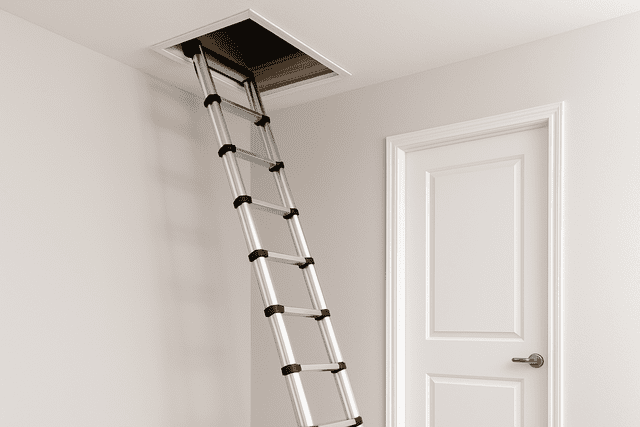
Retractable Ladders That Work With Hatches, Not Against Them
If you’re dealing with a roof hatch, you’ve probably had moments of frustration. Tight clearances, awkward angles, and ladders that don’t seem to match up with the space. It shouldn’t be this hard to make something as simple as climbing through a hatch safe and efficient. Yet, many setups still feel like an afterthought.
The real issue isn’t just the hatch. It’s often the ladder itself.
Standard ladders are designed to go up a wall or lean against something. But when a hatch comes into play, you need something smarter. Something built for compact, vertical spaces with frequent open-and-close use. This is where the right retractable ladder makes all the difference.
Table of Content
Where Most Ladders Go Wrong With Hatches
It’s surprisingly common to see ladders that were clearly not made for hatches being awkwardly forced into those setups. There are a few key reasons this happens.
They’re too steep. Many fixed ladders take up too much floor space. When you’re working with a hatch, especially in narrow corridors or small plant rooms, every inch matters. A steep angle becomes a hazard, not a solution.
They block the hatch. Some ladders get in the way of the hatch lid itself. That’s a problem if it means the hatch can’t fully open or close properly. It can also make climbing through feel clumsy or unsafe.
They aren’t retractable. A static ladder might seem like a low-maintenance option, but if it’s always in the way or doesn’t fold up cleanly, it becomes a daily nuisance.
They’re not built for regular use. Occasional access is one thing. If the hatch is opened often, the ladder needs to feel as stable and smooth on the tenth climb as it did on the first.
It’s clear there’s no one-size-fits-all. Hatch access needs purpose-built solutions.
What Makes a Ladder Truly Compatible With a Hatch?
Not all retractable ladders are built equally. When working with a hatch, it’s important to focus on how the ladder behaves both in use and when it’s stored away.
Here’s what separates a good setup from a frustrating one:
Flush fit
The ladder should sit neatly below or directly behind the hatch opening, not sticking out or pushing against the lid. This allows smooth, clear access.
Controlled movement
A quality retractable ladder for roof access offers a measured, reliable folding mechanism. It shouldn’t spring shut or require a second person to handle. It should move smoothly and stay securely in place, whether you’re folding it away or setting it up for use.
Tidy footprint
Once retracted, the ladder should be out of the way. Whether folded against a wall or tucked into a frame, it needs to respect the space it’s in.
User-first design
Wide treads, good grip, and a handrail where needed. These are details that matter when you’re regularly going up and down with tools or kit in hand.
Compliance-ready
It’s not just about convenience. Ladders need to meet the right safety standards, especially in commercial or industrial buildings. That means correct spacing, structural strength, and load-bearing performance.
If a ladder ticks all of these boxes, it won’t just “work” with the hatch. It will actively improve the usability and safety of that access point.
Ideal Ladder Types for Hatch Setups
Depending on the type of building and access needs, different retractable designs suit different hatch situations. These are the most effective options worth considering:
- Concertina ladders – Compact, foldable, and often customisable to suit specific ceiling heights. Ideal for frequent access where space is tight.
- Scissor-action ladders – Stronger and more industrial in feel, these work well where you need something rugged that still folds away easily.
- Vertical retractables – Great when floor space is limited, and the ladder needs to mount directly above or below the hatch. These are especially handy for plant rooms or roof voids.
- Ceiling-stored options – Some setups allow the ladder to fold into a ceiling box, making it almost invisible when not in use. Perfect where aesthetics matter or in high-traffic areas.
Each type has strengths depending on space, frequency of use, and how the hatch is positioned. The key is matching the ladder to the actual demands of the job, not just choosing the cheapest or most generic option.
When Safety and Convenience Align
A well-designed retractable ladder does more than meet compliance checkboxes. It makes movement seamless. It helps staff do their job faster. It reduces trip hazards and maintenance calls. And it shows that the space has been designed with real users in mind.
This kind of attention to detail matters in facilities management, architecture, and fit-outs, especially in buildings where access is shared across departments or contractors.
When a ladder and hatch work in harmony, it feels like the space is on your side rather than working against you.
Smart Spaces Start With Smarter Ladders
Hatches are fixed. Floorspace is limited. But access can still be easy, safe, and efficient when the right ladder is in place.
If you’ve ever dealt with a clunky, obstructive setup, it’s time to look again. The technology, materials, and engineering now available in retractable systems have come a long way.
Start with the actual needs of the space. Think about the users, not just the specifications. Then choose a ladder that complements the hatch, instead of compromising it. That small decision could change how that access point functions for years to come.


